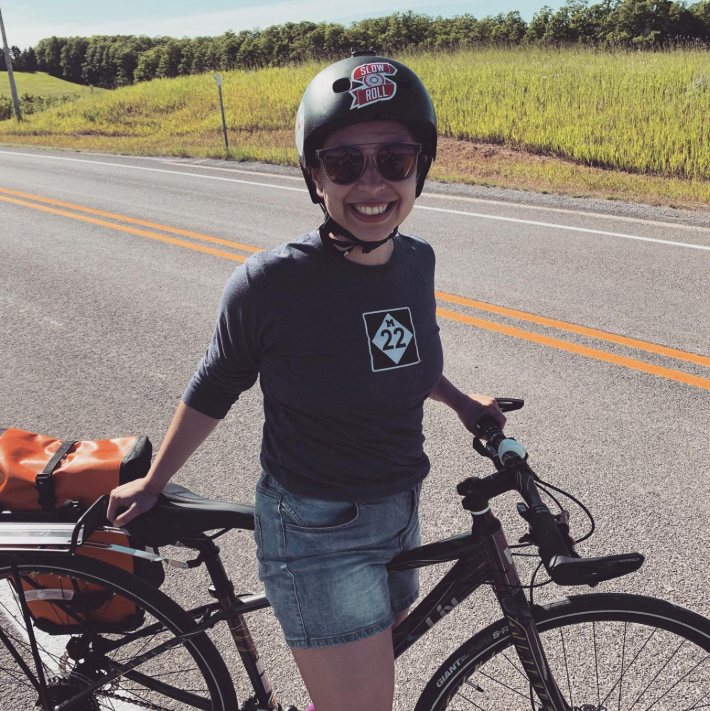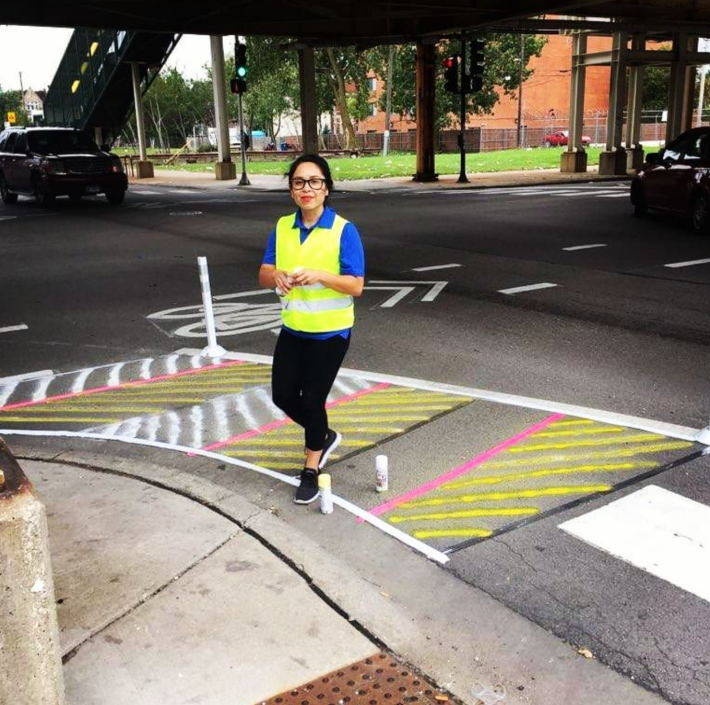Para leer este artículo en español, haga clic aquí.
Streetsblog Chicago is interviewing local Latine transportation leaders in an effort to recognize the diversity, contributions and the presence of people who have helped and continue to shape transportation in Chicago. Late last year, I interviewed Romina Castillo as she entered into the new role of director of outreach and engagement at the Chicago Department of Transportation. Previously, Romina was a Senior Associate at Muse Community + Design, a firm dedicated to urban planning and public engagement. Romina has been leading equitable transportation efforts since 2015, when she began organizing with Slow Roll Chicago.
Ruth Rosas : How did you get into the transportation field?
Romina Castillo: By trade, I’m a planner. Originally, I wanted to focus on spatial planning, but after joining some Slow Roll rides, I took an interest in transportation. I started volunteering with them. After that, I became a community representative for the Mayor’s Bicycle Advisory Council. That was my catalyst to get into the transportation field.
Slow Roll Chicago was the first time I was exposed to a space where people come together to ride for a specific cause. The energy that you experience on those rides was life changing. On those rides, you saw people having fun, talking, all while riding slowly through the city and feeling safe. It was great to be in community with people on bikes. During the three years I volunteered with Slow Roll, I organized multiple rides.
RR: After Slow Roll and MBAC, what work did you get involved in?
RC: After that, my work continued to focus on equity issues in transportation. I focused on building relationships and engaging communities to understand how transportation intersects with everything in their lives. I was brought in as an in-house consultant for Vision Zero initiatives with the Chicago Department of Transportation. I focused on how infrastructure investment and policies shape the safety, or lack of safety, of our streets. In my role as a consultant, I continued to support and helped facilitate the Mayor’s Bicycle and Pedestrian Advisory Councils. I also did some transportation studies where I led some community engagement in Evanston. In West Chicago I worked on a comprehensive plan and led conversations with suburban communities of color on how transportation, or lack thereof, affected their daily lives. I also have done other work related to racial equity, in the form of training, and presentations. I was also part of a team supporting the Chicago Department of Public Health developing a health racial impact assessment tool. In addition, I have also been invested in bringing young voices to transportation-focused engagement processes, especially around the Divvy’s expansion across the City. Some of this work with youth led me to my current role as board member of Territory, an organization where young leaders have the opportunity to be planners and makers of design ideas that can transform their communities.
RR: What are some of the projects you have worked on that have made an impact on you?
RC: Through my work as a consultant working on the Chicago Vision Zero initiatives, I worked on the Vision Zero West Side Plan. The process of making this document made a huge impact on me as a mobility professional. I got to know so many community leaders one on one. These are community leaders who are passionate about safety and mobility in their communities, and we were helping them create spaces to elevate the urgency that residents in their communities had around transportation. Within the plan, we incorporated their needs and priorities. It felt like a true partnership. Beyond the process, the community used the West Side Plan for reference in their own work. The document became a jumping off point for other projects and a place where they could look back and see how things had developed. In this project, I saw the results and of the work I was doing, which went beyond a document. I was able to see first hand how my work was directly impacting people’s lives.
RR: Thank you for sharing that story. I know you have worked with so many communities and those partnerships do have a huge impact on us and how we approach our work. How does your identity impact the work that you do?
RC: I identify as Latina, immigrant, and someone who speaks English as their second language. So when I think about how my identity impacts my work, I am aware that my experiences are very different from a lot of people in my field, but might be similar to some of the people I engage with across the city. For example, as an immigrant woman, who learned English at a later age, I consider how I would have wanted to be engaged to feel safe and comfortable enough to receive information and partake in conversations and discussions with decision makers and government officials. For this reason, I am often making sure that information can be translated, ensuring that the language used in communications to the public can be easily understood and making sure I’m considering and accommodating all people’s needs so they feel like they are not only participants in a conversation, but also decision makers.
I also try to show up at work as my authentic self. When community members ask me questions, I’m honest with them and answer their questions genuinely from my experiences. There aren’t many decision-makers who look like me, and this is why I strongly believe that my role and the role of other professional Latine in the transportation and planning fields are so important. I want our Latine community to know that they are heard and that they have a voice. But beyond that, I want to encourage them to be visionary leaders, to be actively engaged in the decision making that impacts them, and I want them to feel empowered and accountable for the future of our own communities.

RR: Could you speak about your new role at CDOT?
RC: I am the new CDOT director of outreach and engagement and this is a new role. In this position, I’m developing a framework and baseline for engagement in transportation. There are many divisions and departments and all of them have different ways of engaging the public. In my work, I am creating consistency in our communication and engagement so that the public knows what projects are being rolled out, the process for the projects and who’s involved in these projects. The overarching goal is to create transparency and trust. We want to form genuine partnerships with communities and the public at large. And one of the ways we are doing this is through the Chicago Mobility Collaborative. I’ll be leading those meetings from now on as well.

RR: Do you have any current passion projects?
RC : I have this idea to build an English-Spanish dictionary or glossary that contains transportation terms we use in our daily lives as Chicagoans. These would be words that we use that are specific to our context as people who live in Chicago. I would like to provide guidelines for people who do mobility work or report on this work to keep the language consistent. Sometimes I have to translate words for flyers or documents for the city and it is difficult to translate certain words to Spanish. I’m thinking this could be accomplished by bringing in Chicago’s Latine community together who have worked on transportation and having a conversation about the different words we use in Spanish and English.
There are examples of cities who have done this, like Los Angeles. I think it would be great if Chicago had something like that.
To learn more about the Chicago Mobility Collaborative, please visit the website to get involved and find out meeting dates and times.
Ruth Rosas will be on medical leave from Streetsblog until March 2023.

Did you appreciate this article? Please consider making a tax-deductible donation to help fund Streetsblog Chicago's next year of publication. Thanks!





